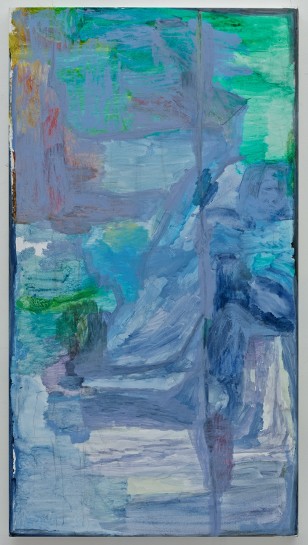
Varda Caivano profiled in ArtReview
Varda Caivano. By Terry R. Myers.
Our profile on the British-Argentine artist, whose paintings exist somewhere on the edge of nameability.
I could argue that Varda Caivano has in productive and meaningful ways been painting versions of the same painting – her painting – ever since I first met her in 2002, soon after she had started the MA in Painting course at the Royal College of Art, London, and I had begun a two-year stint there as visiting professor of painting. Writing this now, I am looking at the small takeaway card she produced for the RCA’s degree show in 2004. On the front is an image of one of her paintings from that exhibition; on the reverse her name, email address (now changed) and mobile number (still the same). Anyone who has paid attention to Caivano’s work over the past decade would immediately recognise this painting as hers. Like most of her work from that time, Untitled, 2004 (it was included in her 2006 Kunstverein Freiburg exhibition), is a smallish canvas (51 by 41 cm), in this case a vertical one. Painted in oil (she would switch to acrylic for two years while pregnant), it pieces together what can be best described as moments of muted colours (blues, greens, yellows, purples and several browns) to make a roughly ovoid shape that takes up all but the left and bottom edges of the canvas. It presents itself as a contemplative accumulation of gentle contradictions, as it is somehow as clear about its ambiguity as it is equivocal about its clarity, fully present yet perpetually in a state of becoming (she’s very, very good at putting down paint that appears material and ethereal all at once), a painting that discusses abstraction, the landscape and/or the body while being all and none of those things itself.
I’ve used ‘discusses’ above on purpose. At first because my conversations with Caivano between 2004 and 2006, while I commuted from Los Angeles, were, of course, discontinuous, each time very much not picking up from wherever we left off, but instead retracing steps from our prior conversations to enter into the new work at hand, finished or not. I do remember that the paintings from the beginning had achieved a level of continuity that is not common even in the work of strong painting students (if only because too many people, including myself, provide contradictory feedback), evidence of her early commitment to a level of focus and a type of simmering development that has served her work very well ever since. Then there is the way in which Caivano regularly describes her paintings, most recently in The Independent: ‘I think the paintings are like thoughts.’ Put another way; thinking about thoughts is, in itself, always a discussion...
- 1
- Doug Aitken
- Njideka Akunyili Crosby
- Milton Avery
- Jules de Balincourt
- Ali Banisadr
- Hernan Bas
- María Berrío
- Varda Caivano
- Saskia Colwell
- Verne Dawson
- Stan Douglas
- Elmgreen & Dragset
- Inka Essenhigh
- Ian Hamilton Finlay
- Barnaby Furnas
- David Harrison
- NS Harsha
- Alex Hartley
- Secundino Hernández
- Ilse D’Hollander
- Christian Holstad
- Kudzanai-Violet Hwami
- Chantal Joffe
- Isaac Julien
- Idris Khan
- Yayoi Kusama
- John Kørner
- Doron Langberg
- Wangechi Mutu
- Alice Neel
- Maria Nepomuceno
- Chris Ofili
- Jorge Pardo
- Celia Paul
- Grayson Perry
- Paula Rego
- Tal R
- Conrad Shawcross
- Hedda Sterne
- Do Ho Suh
- Sarah Sze
- Adriana Varejão
- Suling Wang
- Stephen Willats
- Flora Yukhnovich
- Doug Aitken
- Njideka Akunyili Crosby
- Milton Avery
- Jules de Balincourt
- Ali Banisadr
- Hernan Bas
- María Berrío
- Varda Caivano
- Saskia Colwell
- Verne Dawson
- Stan Douglas
- Elmgreen & Dragset
- Inka Essenhigh
- Ian Hamilton Finlay
- Barnaby Furnas
- David Harrison
- NS Harsha
- Alex Hartley
- Secundino Hernández
- Ilse D’Hollander
- Christian Holstad
- Kudzanai-Violet Hwami
- Chantal Joffe
- Isaac Julien
- Idris Khan
- Yayoi Kusama
- John Kørner
- Doron Langberg
- Wangechi Mutu
- Alice Neel
- Maria Nepomuceno
- Chris Ofili
- Jorge Pardo
- Celia Paul
- Grayson Perry
- Paula Rego
- Tal R
- Conrad Shawcross
- Hedda Sterne
- Do Ho Suh
- Sarah Sze
- Adriana Varejão
- Suling Wang
- Stephen Willats
- Flora Yukhnovich
Victoria Miro Venice
San Marco 1994,
Calle Drio La Chiesa
30124 Venice, Italy
t: +39 041 523 3799
info@victoria-miro.com
View map
Opening Times
During exhibitions:
London: Tuesday–Saturday: 10am–6pm.
Venice: Tuesday–Saturday: 10am–1pm & 2–6pm.
We are also closed on Sundays, Mondays and public holidays.
Admission free.
Enquiries
All general enquiries should be sent to
info@victoria-miro.com
Victoria Miro does not accept unsolicited artist applications.
Before contacting or subscribing please read our Privacy Policy
We respect the choices you make about how you would like to hear from us. You will find links at the bottom of all emails we send from our mailing list which allow you to Update your preferences to change the way we contact you, or Unsubscribe if you want to opt out.
Read our Modern Slavery Statement here.
Read our sustainability statement here.
Subscribe
Staff contact details
Directors
Sales
Exhibitions
Communications
Operations
Technical Services
Finance
This website uses cookies
This site uses cookies to help make it more useful to you. Please contact us to find out more about our Cookie Policy.